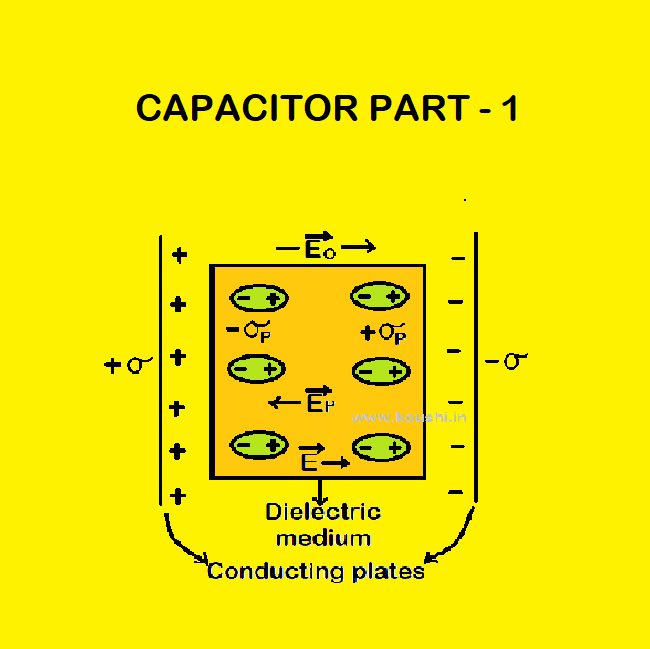Dielectrics: Dielectrics are the insulating materials that have no free charge carriers but when electric field is applied on it, there are equal and opposite induced charges produces in the opposite faces of the material. There are two types of dielectric substances.
(i) Polar: Polar molecules are those molecules whose centre of gravity of positive and negative charges don’t coincide. So they produce a permanent dipole moment. Example – HCL, H2O, N2O, H2S, SO2 etc.
In absence of an external electric field polar molecules are randomly directed, so the net dipole moment of the molecules is zero. When external electric field is applied the molecules align themselves along the direction of the field but the alignment is incomplete due to the thermal vibrations of the molecule.
(ii) Non polar: Non polar molecules are those molecules whose centre of gravity of positive and negative charges coincide. So they don’t produce a permanent dipole moment. Example – H2, N2, O2, CCl4, CO2 etc.
In absence of an external electric field there are no dipole moments of nonpolar molecules. When external electric field is applied the centre of positive and negative charges are separated which produce induced dipole moment.
Dielectric polarization: This is the process when electric field is applied on dielectric material and equal and opposite induced charges produce in the opposite faces of the material.
Let us consider two parallel conducting plates of equal and oppositely charged are separated by a distance and filled with air. The electric field in between the plates is E0 = ![]() (where σ is the surface charge density of plate).
(where σ is the surface charge density of plate).
Now non polar dielectric slab is introduced between the plates and induced charges generate due to dielectric polarization. The induced electric field in the opposite direction of E0 is EP = ![]() (where σP is the surface charge density of the face of dielectric).
(where σP is the surface charge density of the face of dielectric).
So, net field inside the dielectric is E = E0 – EP = ![]() (σ – σP).
(σ – σP).

Dielectric constant: It is the ratio of applied electric field to the net electric field inside dielectric.
Dielectric constant (K) = ![]() =
= ![]() .
.
Polarization vector: The net electric dipole moment per unit volume of a material is called polarization vector.
If p is the electric dipole moment induced in volume V of a dielectric material, then the polarization P = ![]() .
.
If A is the cross sectional area of the dielectric slab and d is the separation between the induced positive and negative charges (amount of charge is q), then volume V = Ad. The dipole moment of dielectric is p = qd. So, polarization vector P = ![]() =
= ![]() =
= ![]() =
= ![]() (surface charge density of polarization charge).
(surface charge density of polarization charge).
SI unit of polarization vector is Cm-2.
Electric susceptibility: The electric susceptibility of a dielectric material is the measure of how easily it can be polarized.
Polarization vector ![]() is directly proportion to the net electric field in the dielectric material.
is directly proportion to the net electric field in the dielectric material.
![]()
![]()
![]()
![]() (P=
(P= ![]() =
= ![]() E as flux EA =
E as flux EA = ![]() )
)
Or, ![]() =
= ![]()
![]()
![]() .
.
Electric susceptibility (![]() ) =
) = ![]() .
.
Relation between electric susceptibility and dielectric constant: The net field inside the dielectric is
E = E0 – EP = ![]() (σ – σP).
(σ – σP).
Or, E0 = E + EP = E + ![]()
Or, E0 = E + ![]() [as P =
[as P = ![]() ]
]
The magnitude of polarization vector P = ![]()
![]() E
E
So, E0 = E + ![]()
Or, E0 = E + ![]() E
E
Or, ![]() = 1 +
= 1 + ![]()
![]() K = 1 +
K = 1 + ![]() .
.
Click the button to go to the next part of this chapter.
